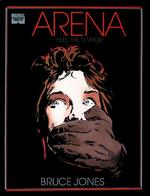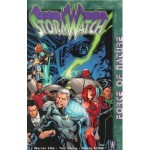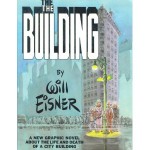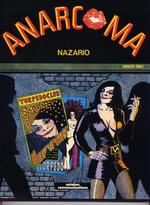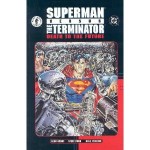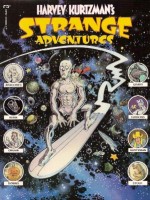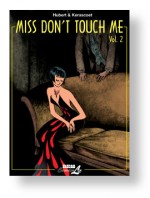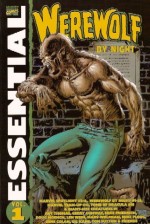
By Gerry Conway, Mike Ploog, Doug Moench & various (Marvel)
ISBN: 978-0-7851-1839-8
Inspiration isn’t everything. In fact as Marvel slowly grew to a position of market dominance in the wake of the losing their two most innovative and inspirational creators, Steve Ditko and Jack Kirby, they did so less by experimentation and more by expanding proven concepts and properties.
The only real exception to this was the en mass creation of horror titles in response to the industry down-turn in superhero sales – a move expedited by a rapid revision in the wordings of the increasingly ineffectual Comics Code Authority rules. Almost overnight nasty monsters (and narcotics – but that’s another story) became acceptable fare within four-colour pages and whilst a parade of 1950s pre-code reprints made sound business sense (so they repackaged a bunch of those too) the creative aspect of the contemporary fascination in supernatural themes was catered to by adapting popular cultural icons before risking whole new concepts on an untested public.
As always the watch-world was fashion: what was hitting big outside comics was to be incorporated into the mix as soon as possible. When proto-monster Morbius, the Living Vampire debuted in Amazing Spider-Man #101 (October 1971) and the sky failed to fall in Marvel moved ahead with a line of scary superstars – beginning with a werewolf and a vampire – before chancing something new in a haunted biker who could tap into both Easy Rider’s freewheeling motorcycling chic and the supernatural zeitgeist.
Werewolf By Night debuted in Marvel Spotlight #2 (preceded by western masked hero Red Wolf in #1, and followed by the afore-hinted Ghost Rider) although the title, if not the character, was cribbed from a classic monster-short thriller from Marvel Tales #116, July 1953.
Marvel had a long-time tradition of using old (presumably already copyrighted) names and titles when creating new series and characters. Hulk, Thor, Magneto, Doctor Strange and many others all got nominal starts as throwaways in an anthology…
This copious compendium collects in moody monochrome the early adventures of a young West Coast werewolf and includes Marvel Spotlight #2-4, Werewolf By Night Volume 1 #1-21, Giant-Size Creatures #1, a guest appearance in Marvel Team-Up #12 and the appropriate half of a horror crossover with Tomb of Dracula #18 and begins with the landmark first appearance which introduced young Jack Russell, a teenager with some very disturbing dreams…
‘Werewolf by Night!’ (Marvel Spotlight #2, February 1972, written by Gerry Conway and illustrated by Mike Ploog from an outline by Roy & Jeanie Thomas) described the worst day of Jack’s life – his 18th birthday, which began with nightmares and ended in something far worse.
Jack’s mom and little sister Lissa were wonderful but his new stepfather Philip and the creepy chauffeur Grant were another matter… That night at his party Jack had a painful seizure and fled into the Malibu night transforming into a ravening vulpine man-beast. The next morning he awoke wasted on the beach to discover that his mother had been gravely injured in a car-crash. Something had happened to her brakes…
He crept into her hospital room and she told him the story of his blood-father; an Eastern European noble who loved her deeply but locked himself away three nights every month… The Russoff line was cursed by the taint of Lycanthopy: every child doomed to become a wolf-thing under the full-moon from the moment they reached eighteen. Jack was horrified and then realised how soon his sister would reach her own majority…
With her dying breath Laura Russell made her son promise never to harm his stepfather, no matter what…
Scenario set with the wolf-boy transforming for three nights every month, the weird, wild wonderment began in earnest with the beast attacking Grant the chauffeur – who had fixed those brakes – but the beast-boy refrained, even in vulpine form, from attacking Philip Russell…
The untitled second instalment saw the monster rescue Lissa from a skeevy biker gang (they were everywhere back then) and narrowly escape the police only to be abducted by a sinister dowager seeking knowledge of a magical tome called the Darkhold – an eldritch spellbook that was the basis of the Russoff curse, whilst the third tryout issue ‘Island of the Damned!’ introduced Buck Cowan, an aging writer who became Jack’s best friend as the pair began to jointly investigate the wolf-boy’s stepfather.
The elder Russell had apparently sold off Jack’s inheritance leaving the boy nothing but an old book. Following a paper trail to find proof Philip had had Laura Russell killed led the pair to an offshore fortress, a dungeon full of horrors and a ruthless mutant seductress…
That episode ended on a cliffhanger, presumably as added incentive to buy Werewolf By Night #1(September 1972) wherein Frank Chiaramonte took over inking with ‘Eye of the Beholder!’ as deadly freak Marlene Blackgar and her monstrous posse captured the entire Russell family looking for the Book of Sins. Once more, as night fell a fearsome force of supernature awoke to accidentally save the day…
With ‘The Hunter… and the Hunted!’ Jack and Buck left the grimoire that had caused so much trouble with Father Joquez, a Christian monk and scholar of ancient texts, but even so they were still hunted because of it. Jack left the rural wastes of Malibu for a new home in Los Angeles, trading concrete for forests but life was no easier.
Dying scientist Cephalos wanted to harness Jack’s feral life-force to extend his own and lived but briefly to regret. Meanwhile Joquez succeeded in translating the Darkhold, but his accomplishment allowed an ancient horror to possess him in ‘The Mystery of the Mad Monk!’ and whilst the werewolf was saddened to end such a noble life it felt far happier dealing with millionaire sportsman Joshua Kane, who wanted a truly unique head mounted on the wall of his den in ‘The Danger Game’ (inked by Franke Bolle).
Half-naked, exhausted and soaked to his now hairless skin Jack next had to deal with Kane’s psychotic brother who wanted the werewolf for his pet assassin in ‘A Life for a Death!’ by Len Wein and Ploog, before ‘Carnival of Fear!’ (Wein, Ploog & Bolle) found the beast a captive of the mystic Swami Calliope and his deadly circus of freaks. The wolf was now the subject of an obsessive police detective too. Lou Hackett was an “old-school cop†– an old buddy of trophy-hunter Joshua Kane and every bit as charming: but his off-the-books investigation had hardly begun when the Swami’s plans fell apart in the concluding ‘Ritual of Blood!’ (inked by Jim Mooney).
The beast was safely(?) loose in the backwoods for #8’s quirky monster-mash when an ancient demon possessed a cute little bunny in ‘The Lurker Behind the Door!‘ (Wein, Werner Roth & Paul Reinman) before returning to LA and ‘Terror Beneath the Earth!’ (Conway, Tom Sutton & George Roussos) and impeding a nefarious scheme by business cartel the Committee. These out-of the-box commercial gurus somehow had a full dossier on Jack Russell’s night-life and a radical plan to use monsters and derelicts to boost sales in a down-turned economy.
However their bold sales scheme to frighten folk into spending more was over before it began as the werewolf proved to be far from a team-player in the wrap up ‘The Sinister Secret of Sarnak!’
Werewolf by Night #11 saw Marv Wolfman sign on as writer for ‘Comes the Hangman’ (illustrated by the incredible Gil Kane and Tom Sutton), in which we learned something interesting about Philip Russell and the Committee, whilst Jack’s attention was distracted by a new apartment, a very odd neighbour and a serial kidnapper abducting young women to keep them safe from “corruption.†When he took Lissa Russell the hooded maniac soon found himself hunted…
The concluding chapter ‘Cry Werewolf!’ introduced the criminally underappreciated Don Perlin as inker, who would in a few short months become the strip’s penciller for the rest of the run, but before that Ploog and Chiaramonte returned for another session, introducing a manic mystic and a new love-interest (not the same person) in ‘His Name is Taboo’. An aged sorcerer wanted the werewolf’s energies for his own arcane purposes but his adopted daughter Topaz found her loyalties divided and her psionic abilities more help than hindrance to the ravening moon-beast.
‘Lo, the Monster Strikes!’ pitted the wolf against Taboo’s undead son and saw revelation and reconciliation between Philip and Jack Russell. As a result the young man and new girlfriend Topaz set off for Transylvania, the ancestral Russoff estate and a crossover confrontation with the Lord of Vampires.
Tomb of Dracula #18 (March 1974) began the clash in ‘Enter: Werewolf by Night’ (by Wolfman, Gene Colan & Tom Palmer) as Jack and Topaz investigated a possible cure for lycanthropy, only to be attacked by Dracula. Driven off by the girl’s psychic powers the Count realised the threat she posed to him and determined to slay her… In Werewolf by Night #15 ‘Death of a Monster!’ (Wolfman, Ploog & Chiaramonte) the battle of the beasts resolved into a draw, but only after Jack learned of his family’s long connection to Dracula…
Sadder, wiser but no less accursed, Jack headed back to America with Topaz but a unplanned stopover in Paris led to an impromptu clash with a modern incarnation of the Hunchback of Notre Dame (he doesn’t sing and he’s not very gentle here) in Ploog’s farewell performance ‘Death in the Cathedral!’
Issue #17 ‘The Behemoth!’ by Mike Friedrich and Don Perlin, saw Jack and Topaz escape Paris only to fall into the Committee’s latest scheme as the blustering Baron Thunder and his favourite monster tried to make the werewolf their plaything again, before the secret of Jack’s mystery neighbour was revealed in ‘Murder by Moonlight!’ as Thunder attacked again aided by witch-queen Ma Mayhem. However that was all a feint for the Committee to kidnap Lissa who would, one day, be a werewolf too…
Whilst searching for his sister Jack fell foul of two undead film-stars haunting the Hollywood backlots in #19’s ‘Vampires on the Moon’ whilst Giant-Size Creatures #1 re-imagined a failed costumed crusader to introduce a new hairy hero in ‘Tigra the Were-Woman!’ (Tony Isabella, Perlin and Vince Colletta) as Greer Nelson, one-time feminist avenger The Cat, was “killed†by Hydra agents, revived by ancient Cat-People and became an unwilling object of temporary affection to the feral and frisky Jack Russell…
Following ‘Waiter, there’s a Werewolf in my Soup!’ a text piece also from Giant-Size Creatures that explained the genesis of Marvel’s horror line, WBN #20 brought aboard Doug Moench to wrap up all the disparate plot threads in ‘Eye of the Wolf!’, a rushed but satisfactory conclusion featuring many werewolves, Thunder, Mayhem and lots and lots of action.
With the decks cleared Moench began to make the series uniquely his own, beginning with #21’s ‘One Wolf’s Cure… Another’s Poison!’ as the writer began playing up the ever encroaching 18th birthday of little Lissa and engineered the final reckoning with off-the-rails cop Lou Hackett, who had been going increasingly crazy in his hunt for the werewolf…
With the stage set for some truly outrageous yarn-spinning (all covered in a second Essential volume) this first compendium ends with a slight but engaging Marvel Team-Up #12 wherein Wein, Conway, Ross Andru and Don Perlin produced ‘Wolf at Bay!’ as the Wall-Crawler met the Werewolf and battled malevolent Mage Moondark in foggy, fearful San Francisco.
Topped off with the werewolf’s text entry from the Marvel Universe Handbook and an unused Ploog cover for Marvel Spotlight #4, this moody masterpiece of macabre menace and all-out animal action covers some of the most under-appreciated magic moments in Marvel history; tense, suspenseful and solidly compelling. If you must have a mixed bag of lycanthropes, bloodsuckers and moody young misses – this is a far more entertaining mix than many modern movies, books or miscellaneous matter…
© 1972, 1973, 1974, 2005 Marvel Characters, Inc. All Rights Reserved.
